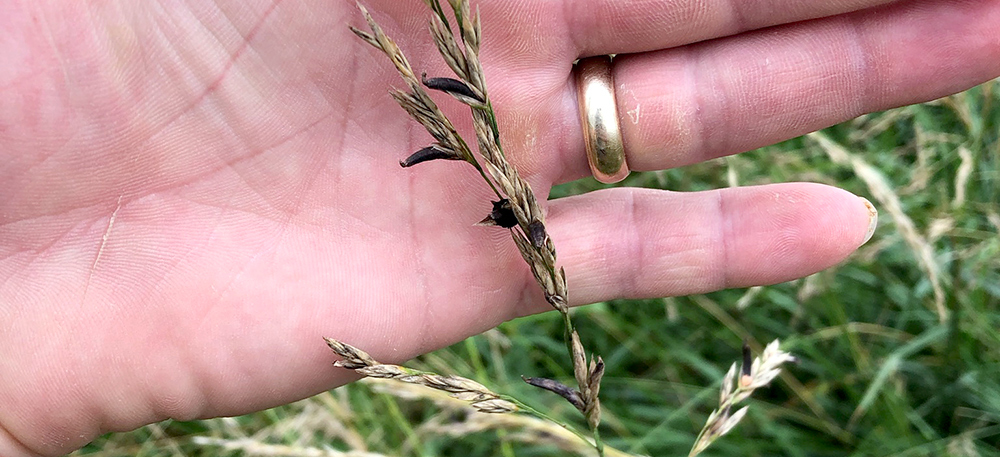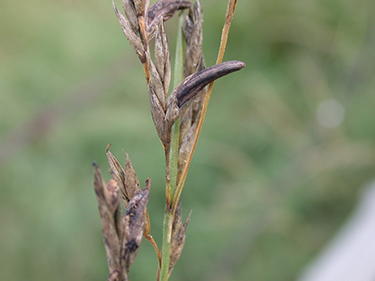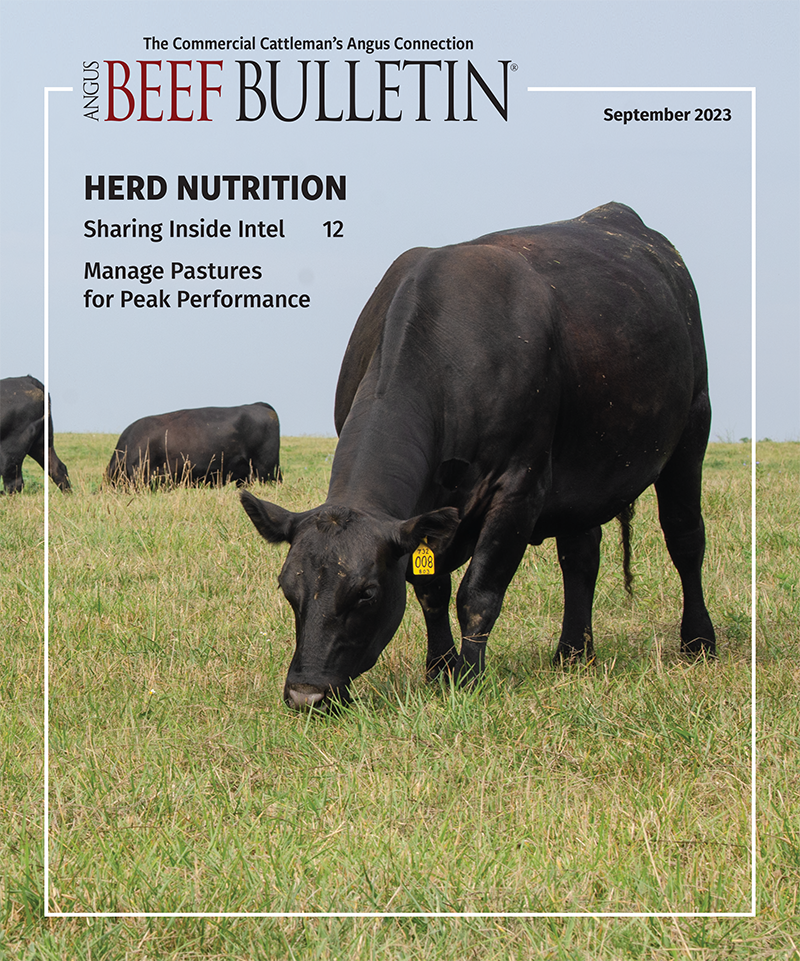
High Ergot Levels Negatively Affect Cattle
Symptoms to watch for when cattle are consuming ergot-infected feeds.
Ergot is a fungus that grows on certain grasses and grains when moisture conditions are just right. It becomes a problem mainly after a wet growing season, but rarely during dry conditions. The fungus replaces the seedhead with a dark brown/black mass and produces toxic alkaloids. One or more of the kernels in the seedhead are replaced with this dark, hard “ergot body.”
Various types of alkaloids in ergot affect cattle in different ways. Some affect the nervous system, resulting in muscle spasms in the hind legs, incoordination, loss of balance and sometimes a temporary paralysis. More commonly, the alkaloids impair blood circulation to extremities (due to constricted blood vessels), which can result in loss of ears, tail or feet. Mild cases of ergot poisoning may show up as poor production — lower weight gain, reduced milk production, inability to handle hot or cold weather, reproductive problems or abortion. The alkaloids restrict blood and milk flow.
Ergot is most common in grains, but it can also infect wheatgrass, brome, wild rye and a number of other wild grasses. An ergot fungus that grows mainly on rye produces a condition called ryegrass staggers in cattle. Another type infects barley and creates another class of toxins.
Research is looking at how the ergot develops and how long it takes for the ergot body to start putting alkaloids into the seed. Feeding trials at the University of Saskatchewan aimed to determine the threshold at which performance is reduced due to ergot contamination of the feed and investigating the different alkaloids.
Jenna Sarich, a student at the university, has been researching ergot levels in cattle feed. She found that feedlot cattle develop problems even when levels are within what has been considered safe limits, especially during warmer temperatures.
She started her master’s studies with Gabriel Ribeiro, whose research focus is on developing nutritional strategies to improve health, performance and profitability of beef cattle, which includes optimizing grain- and forage-processing technologies to improve rumen health, feed efficiency and beef cattle productivity.
“There were three parts to my master’s project,” explains Sarich. “In the first one, we took samples from across western Canada and analyzed the profiles of these ergot-contaminated feed samples. We wanted to see if the toxicity of ergot changes based on location, climate or the crop it was growing in.”
This was a full study, starting at the beginning of the background period in early November continuing all the way to the end of finishing in late June for a total of 231 days.

The ergot fungus replaces the seedhead with a dark brown/black mass and produces toxic alkaloids. [Photo courtesy University of Arkansas.] |
The second part of her project was studying ergot in the rumen. Sarich collected rumen fluid and feed material from the gut of a cannulated animal and put it into an artificial rumen (RUSITEC).
“It has artificial saliva coming in and a port for liquid coming out,” Sarich explains. “We were able to collect the gas produced, and it also had continuous mixing to simulate actual rumen contractions. We ‘fed’ the ergot into this, at toxic levels of 20 ppm (parts per million), to see its effects on the microbiome within the simulated rumen. We also fed a mycotoxin binder, to see if this might help alleviate the impact.” This study is now published in the Journal of Animal Science.
The third part involved cattle in the feedlot at the Livestock and Forage Center of Excellence near Saskatoon. Sarich had 240 steers separated into 16 different pens. She then fed different levels of ergot, all within the recommended levels, which currently is 2 ppm to 3 ppm. Ergot toxicity changes depending on many factors, she says, so it’s difficult to pinpoint exactly how much is safe. The steers’ diets had ergot alkaloids included at increasing levels: 0 (control, without ergot), 0.75 ppm, 1.5 ppm and 3 ppm.
“We saw some effects during backgrounding, but these were not as evident as coming into the finishing phase when we started seeing symptoms after daytime temperatures reached about 68° F,” Sarich says. “The animals on the 3-ppm diet had increased respiratory rate and open-mouthed panting with increased saliva (drooling) and heat stress symptoms. We also saw them splashing in their watering bowl, trying to cool themselves.”
This created muddy conditions in their pen. Cattle would lie in the mud to try to cool off, she explains. “We’d know which cattle were receiving the 3 ppm level in their feed just by the state of their pen.”
Weather that spring was very hot, and it was forecasted to increase with no overnight cooling. On May 13 the researchers took those animals off the 3-ppm diet and started feeding them the control diet.
This wasn’t part of the study, but it added an interesting facet, says Sarich. “We saw these animals experience a significant drop in dry-matter intake and average daily gain when they showed signs of heat stress. We took them off the ergot and started feeding the control diet. By the end of the study — about 40 days later — they had significant compensatory gain and ended up about the same weight as the control animals.”
The steers receiving the second-highest concentration (1.5 ppm) continued to have reduced growth performance, but to a lesser extent than the animals on the 3-ppm diet, she explains.
Study results showed there was a significant increase in body temperature in animals on high levels of ergot. Body temperature increased with more ergot in the diet with a parallel decrease in performance.
During the study, many other measurements were taken, as well. Ergot causes specific symptoms if the animals consumed ergot at toxic levels; mainly, the blood vessels constrict.
“They may lose blood flow to ears, tail and limbs,” Sarich explains. “I took thermogram images of the head and ears to make sure we could see any changes in blood flow to the ears.”
The study also analyzed the feet to check for any lameness due to constricted blood flow. They used GrowSafe Systems to measure individual feed intake and behavior. Researchers collected data on growth performance, body temperature, blood and hair parameters, and carcass performance.
The results in this study show that if cattle producers feed ergot-infected forage, they should do so at levels less than 1.5 ppm, especially during spring and summer (warmer weather), since performance and welfare of the animals were affected when consuming levels higher than 0.75 ppm.
Editor’s note: Heather Smith Thomas is a freelance writer and cattlewoman from Salmon, Idaho. [Lead photo courtesy University of Missouri.]



